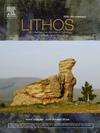Age and origin of the Amdo ophiolite, central Tibet: New constraints on the evolution of the Bangong-Nujiang archipelagic ocean
IF 2.9
2区 地球科学
Q2 GEOCHEMISTRY & GEOPHYSICS
引用次数: 0
Abstract
The central segment of the Bangong-Nujiang suture zone features multiple branching sub-sutures, yet the tectonic characteristics and evolutionary history of the associated ocean basin remain poorly understood. This study presents a detailed analysis of the field geology, geochronology, and petrogeochemical features of the Amdo ophiolite, located in the northernmost part of the suture zone. The Amdo ophiolite preserves a relatively complete sequence of oceanic lithosphere, including mantle peridotites, cumulate gabbros, sheeted dikes, and pillow lavas, arranged from bottom to top. The oceanic crust sequence is unusually thin, measuring less than 3 km, suggesting formation in a restricted oceanic basin. Zircon U-Pb dating of mafic rocks and plagiogranites reveals that the Amdo ophiolite formed during 184181 Ma, consistent with the age of the Dongqiao ophiolite located to its west. Geochemically, the mantle peridotites display refractory compositions akin to forearc peridotites, while the mafic rocks exhibit high MgO, low TiO2, and rare earth element (REE) patterns similar to N-MORB, with notable depletion in Nb, Ta, and Ti and enrichment in large-ion lithophile elements (LILE). These geochemical features are indicative of supra-subduction zone (SSZ) ophiolites. Combined with evidence from the regional forearc mélange, oceanic crust-type retrograde eclogite, and associated island arc magmatic rocks, the data suggest that the Amdo ophiolite originated from a trench-arc system. It represents the remnants of Early Jurassic forearc extension within the northern branch of the Bangong-Nujiang Ocean. Thus, our study further elucidates the early evolutionary processes of the northern branch within the Bangong-Nujiang archipelagic ocean. It provides crucial insights into the evolution of an archipelagic ocean and the complex orogenic processes involving the multiphase assembly of microcontinents and accretionary terranes.
西藏中部安多蛇绿岩的时代和成因:班公-怒江群岛洋演化的新约束
班公-怒江缝合带中部具有多分支亚缝合线,但其相关洋盆的构造特征和演化历史尚不清楚。本文对安多蛇绿岩的野外地质、年代学和岩石地球化学特征进行了详细分析。安多蛇绿岩保存了相对完整的海洋岩石圈序列,包括地幔橄榄岩、堆积辉长岩、片状脉和枕状熔岩,由下向上排列。海洋地壳层序异常薄,测量不到3公里,表明形成于一个有限的海洋盆地。基性岩和斜长花岗岩的锆石U-Pb定年结果表明,安多蛇绿岩形成于184181 Ma,与安多蛇绿岩西部的东桥蛇绿岩年龄一致。地幔橄榄岩的地球化学特征与弧前橄榄岩相似,呈现出高MgO、低TiO2和稀土元素(REE)模式,与N-MORB相似,且Nb、Ta、Ti富集,而大离子亲石元素(LILE)富集。这些地球化学特征是超俯冲带蛇绿岩的指示。结合区域弧前岩、洋壳型逆行榴辉岩及相关岛弧岩浆岩资料,认为安多蛇绿岩起源于海沟-弧体系。它代表了早侏罗世班公-怒江洋北支内的前弧伸展残余。因此,本研究进一步阐明了班公-怒江群岛洋北支的早期演化过程。它为群岛海洋的演化和复杂的造山过程提供了重要的见解,这些造山过程涉及微大陆和增生地体的多阶段组合。
本文章由计算机程序翻译,如有差异,请以英文原文为准。
求助全文
约1分钟内获得全文
求助全文
来源期刊

Lithos
地学-地球化学与地球物理
CiteScore
6.80
自引率
11.40%
发文量
286
审稿时长
3.5 months
期刊介绍:
Lithos publishes original research papers on the petrology, geochemistry and petrogenesis of igneous and metamorphic rocks. Papers on mineralogy/mineral physics related to petrology and petrogenetic problems are also welcomed.
 求助内容:
求助内容: 应助结果提醒方式:
应助结果提醒方式:


